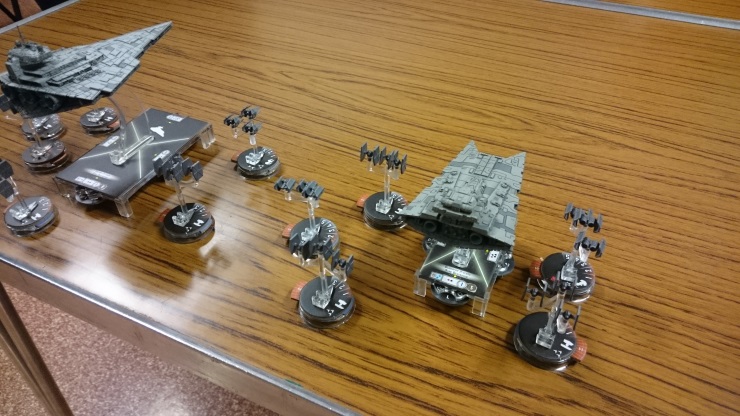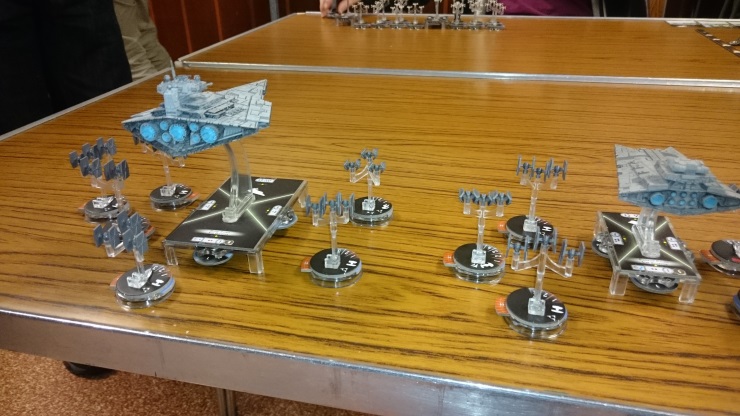Fantasy Flight Games had to do a lot of persuading to convince me to try its latest “flagship” game. Puns aside, there were several large factors that made me hesitant to even step into a room with the latest behemoth, one of them being the large price point on release: it seemed excessive considering the content on offer. The second being the major concerns I shared with its older but smaller sibling, the original X-Wing Miniatures game and the wave after wave of expansions that seemed tacked on simply to cash in on a very popular dogfighting game using very tenuous connections. I left that particular party very early on once the core models had been released, and saw no reason to pick up the K-Wing or Tie Defender. To me, it seemed too much of a play for my wallet than a way to improve the game.
Now though, the price on the core Armada set seems to have dropped to make it a more reasonable proposition, and the expansions are more likely to be tied into the exciting new seventh episode than the expanded universe. So with those thoughts pinned to the front of my brain, I dived in to see if Armada really is the fleet battle I’ve been looking for.
The box is the same rather large size of Imperial Assault, and true to form Fantasy Flight decide to keep their trench storage feature. This still remains a mystery to me, considering most of the components would be better off suited to a series of trays instead of the setup we know and despair over. The main capital ships have their own storage part in the box, while the rest of the components will have to make do with getting cosy in the trench.

Unlike its older X-wing sister, the ships in Armada aren’t exactly to scale and this is a good thing. Some of you will remember how cumbersome the scaled-up blockade runner looked in the X-wing game, and with the realisation of how big a Star Destroyer would have to be, the disregard of this attention to detail means that we can look forward to seeing all the capital ships in the follow-up waves. The possibility of taking charge of the Avenger or a Mon Calamari Cruiser in the future fills the Star Wars fanboy’s cup of joy to the brim. While the detail in the larger capital ships is superb in terms of the minute amount of details, the smaller fighters haven’t been given the care and attention of the larger ships. With no paint job or intricate detail you be forgiven for feeling slightly let down at the lack of care that seems to have been bestowed on them.
If my comments so far seem like I’m preparing to rain scorn upon Armada then let me put your mind at ease. These criticisms are akin to complaining about the type of font being used in a restaurant menu after eating a four course meal where your taste buds exploded with sheer joy during every dish. Armada is a simply outstanding experience, and even goes so far as to correct many of the inherent niggles within its older sister.
Those expecting a simple rehash of X-wing are in for a surprise: Armada is designed to be brutal and fast and over within six rounds, which will maybe please those who could occasionally be caught up in the slow attrition that X-wing often brought to the starfield table. You simply don’t have the time to plan an overpowering flank, or a build up a clever feint before springing the winning trap. You see the enemy fleet before you and you engage almost immediately, using a combination of your capital ships and snub fighters.

The hidden move dials from X-wing make an appearance again, but this time they decide on your main ship’s actions from a choice of four. You can make changes to your speed, or order your fighters to attack immediately. You can repair your ship or concentrate your firepower for attacking. You can hold back using the action immediately and exchange it for a token instead that you can use at another point in the game, which gives you strategic options and keeps your opponent guessing. The larger Imperial ships get more action dials which sounds like an advantage, but it means that you have to plan your action sometimes three turns in advance, reflecting that the larger ships take more time to react, while the smaller Rebel Blockade runner only has one dial, so you are able to react straight away to dangerous situations immediately and save your skin. So while your actions can change, your speed often remains constant, and the only difference is how you move, not necessarily the distance – and because everyone has a 360 degree firing arc, you often charge into the fray and rely on the fighters providing back up.
Your capital ships have four sides of attack and defence and only have shields and defense tokens they can activate in order to deflect attacks. The fighters get an even worse deal, because like the ships they don’t have defence dice and rely more on the luck of poor attacking dice and higher hull values to survive. Even the rebel fighters don’t have shields (a change from X-wing), but this is welcome: you want the fighters to be there to draw off the fire from your main ships, and a clever engagement rule makes that the case. You’ll be guaranteed to lose one or two squadrons during a match but often for the greater good. Losing ships gives your enemies the assigned card value, and points decide the overall winner, as it’s unusual for an entire fleet to be destroyed during a battle. It means that it’s worthwhile taking out as many fighters as you can, as this can often tip the balance of the game and sometimes win you it by a matter of ten points. As with X-wing, you’ll be able to bring on pilots that offer additional skills to give you an advantage, though they will come at a higher cost to you to field them as part of your fleet. Expect additional expansions in the future to offer more characters with some returning familiar faces from X-wing as well.

You’ll take turns moving and attacking your capital ships, before taking turns activating and either moving or attacking with your fighters. You’ll use defence tokens to evade fire or move damage to another part of the ship, or reduce the damage, or you’ll call in your fighters for support and you’ll love every last sweet minute of it because somehow, Fantasy Flight have managed to take everything that has started to grate with me about X-wing and simply not make it part of the game. You’ll feel the majesty as the capital ships go broadside at each other and feel a massive sense of satisfaction overpowering a Rebel Ship with a squadron of TIE Fighters. You’ll curse when a plan fails due to an unexpected action from your opponent, and grin from ear to ear when you win the game by the smallest margin of points.
More importantly, there is more than enough content in the box to keep you playing for some time. You won’t need to fork out for expansions straight away, which is very welcome indeed, and would have felt extremely rude considering the asking price for the core set. That won’t of course stop me from grabbing a rebel and imperial squadron, because when the game is up and running it looks like a space battle. So the more the merrier.
Armada has completely blindsided me with the overall package on offer. It’s easy to pick up and play and you’ll learn the game very quickly. Learning winning tactics will take time but you’ll have so much fun doing so. The capital ships look outstanding, but some of you might want to take your brush to the squadrons to give them some individuality. It doesn’t matter if you are a fan of Star Wars or Fantasy Flight or even X-wing, you have to go out and buy this, borrow it or get it on your Christmas list. You owe yourself to be playing this as soon as you can.





